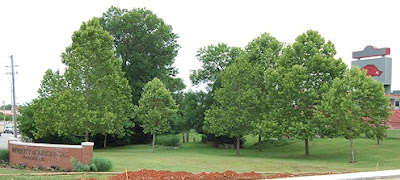A sign, placed by the University of Arkansas Alumni, reads:
On Jan. 13, 1839, a group of 1,100 Cherokees led by John Benge passed through the frontier village of Fayetteville. They were traveling on the Trail of Tears from the Cherokee homelands in Georgia, Alabama, and Tennessee to 'Indian Territory'(Oklahoma) as part of the forced removal of nearly 13,000 Cherokees ordered by President Andrew Jackson and the U S Congress. The Benge Party camped on the hillside to the north and east of this marker, near a creek and pond, secured supplies and repaired their wagons. They headed west on the Cane Hill Road the next day, arriving in Indian Territory on Jan.17, 1839.
Benge's Party had left from just south of present day Ft.Payne, Alabama around the end of September 1838. They arrived at Woodall's Farm near present day Westville Oklahoma on Jan.17 1839. They reported 33 deaths and 3 births among the party. Their route of travel had taken them through northeastern Arkansas near Batesville, through Norfork, Flippin, Yellville, Harrison, Alpena, Huntsville and over present day highways 74 and 16 to Fayetteville.
In 1998, a small park was created at the location of the Benge encampment.
THE BENGE DETACHMENT OF THE CHEROKEE
The Indian Removal Act was signed by President Andrew Jackson on May 28, 1830. This act put in motion the systematic removal of the Cherokees, Choctaws, Muskogee Creeks, Chickasaws, and Seminoles from their ancestral homelands to Indian Territory.
By June 1838 there were still about 15,000 Cherokees in the southern Appalachians. They were rounded up, divided into 17 'detainment' groups and forced to move west. Thirteen of these detachments traveled through Northwest Arkansas by several different routes, mostly overland, but at least one traveled by river.
The first 4 detachments traveled with military escorts, but the 13 subsequent detachments were allowed to complete the removal under the leadership of Chief John Ross. Each detachment was led by a Cherokee leader called a conductor. John Benge was the conductor for a detachment that traveled a different route from any of the other detachments, one that led them across southeast Missouri and northern Arkansas.
John Benge "Wagonmaster John," was the "half-breed" Cherokee. His grandfather, John Benge, was a Scot trader whose 2nd wife was Cherokee.
On September 28, 1838, some 1200 men, women, and children started west from Wills Valley, Alabama, just south of Fort Payne. Many were related by blood, marriage, and/or religious affiliation, many having been converted to Christianity, primarily Methodist or Baptist. Though some in the group were poor, others were wealthy enough to own slaves. A few Creeks and 114 Negroes were in the group. Small groups left each day until the last left on Oct 1. Additional families joined as they traveled up the Tennessee River. There were 33 deaths, primarily measles and whooping cough; 3 births recorded. 1132 people arrived in Oklahoma.
The US Government furnished 60 wagons and teams and 480 riding horses and allotted $66.24 for each Cherokee for 80 days of travel. Even though the Benge detachment averaged 10 miles per day, a fast pace among the groups traveling overland, the 80 day allotment was not enough; the 768 mile trip took 106 days.
Members of the detachment rode in the wagons and on horseback. Some 600 horses had to be fed along 1,200 people, so provisions had to be purchased along the way. Much of what is known or the Trail of Tears is due to purchase records and newspaper accounts as the groups passed through an area.
The detachment crossed the Mississippi River into present-day Missouri at Iron Banks, now Columbia, Kentucky, in mid-November 1838. They turned southwest and crossed into Arkansas at Indian Ford on the Current River around Dec 8. Following the route known as the Southwest Trail or the Old Spanish Road, they passed through Smithville and near Batesville, where some of the party halted for wagon repairs. Turning westward, they crossed the White River near Talbert’s Ferry. Since the rivers were low, they drove, rode, or waded through the icy water rather than paying the fare for the ferry service.
The detachment arrived at Stone’s Farm or Johnson’s Switch near Fayetteville on Jan 13, 1839. They camped along a creek and up the hill from what is today the intersection of Martin Luther King Boulevard and Stadium Drive.
On Jan 14, 1839, the detachment was on the road to Cane Hill. The Benge detachment ended their journey at Mrs. Webber’s farm near present-day Stilwell, Oklahoma, on Jan 17, 1839.

















No comments:
Post a Comment